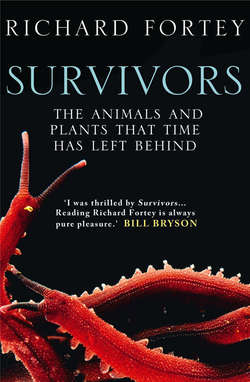Survivors: The Animals and Plants that Time has Left Behind

Реклама. ООО «ЛитРес», ИНН: 7719571260.
Оглавление
Richard Fortey. Survivors: The Animals and Plants that Time has Left Behind
Survivors
Richard Fortey
Dedication
Contents
PROLOGUE
TABLE OF GEOLOGICAL PERIODS
1
Old Horseshoes
2
The Search for the Velvet Worm
3
Slimy Mounds
4
Life in Hot Water
5
An Inveterate Bunch
6
Greenery
7
Of Fishes and Hellbenders
8
Heat in the Blood
9
Islands, Ice
10
Survivors Against the Odds
EPILOGUE
Picture Section
GLOSSARY
PICTURE CREDITS
FURTHER READING
SEARCHABLE TERMS
ACKNOWLEDGEMENTS
By the same author
Copyright
About the Publisher
Отрывок из книги
The Animals and Plants That Time Has Left Behind
Title Page
.....
2. A growth series of juvenile Tachypleus tridentatus, the Asian species of horseshoe crab, collected from tide strand lines in Deep Bay estuary, Hong Kong. (The scale is a 15 cm/6 in ruler.)
As for the place of the horseshoe crab in the tree of evolution, the Latin name of the horseshoe crab I saw in southern Thailand might offer a clue. Carcinoscorpius means ‘crab scorpion’, and that is what these curious creatures are: superficially crab-like relatives of the scorpions. They are the most primitive living examples of a great group of arthropods that includes all living spiders and mites as well as scorpions, and several less familiar kinds of animals. This group is referred to as chelicerates, after those special appendages – chelicerae – located on the head-shield, which they all share in one form or another. All the relatives of the horseshoe crab I have mentioned live on land. But the cradle of life was the sea, and Limulus and its relatives take us back to the far, far distant days when the land surface was barren of larger organisms.
.....